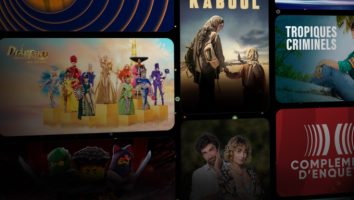When Walt Disney and Warner Bros. Feature Animation unveiled scenes from their respective 2001 feature releases at this year’s Comic-Con International: San Diego, something was quickly and enthusiastically noticed by the audience in attendance. Both films look and feel radically different from the classic Disney-style animated features of the 20th Century.
Well aware of the popularity of CGI features (Toy Story, Antz, etc.), alternative styles (primarily from features based on hit series like Rugrats and Pokémon) and different techniques (Chicken Run’s clay animation), Warner and Disney now know that to lure audiences in to a primarily hand-drawn 2-D feature requires new thinking-and a new look. After the poor box-office performance of such traditional-looking films as The Iron Giant, Titan A.E. and The Road to El Dorado, the two largest U.S. animation producers are gearing up for a makeover.
Osmosis Jones from Warner Bros. and Atlantis: The Lost Empire from Disney are radically different from each other and most animated features that have come before them. Jones, supervised by the Farrelly Brothers (There’s Something About Mary, Me, Myself & Irene), is a wild comedy about two allies inside the blood stream of a body named Frank (played in live action by Bill Murray). Osmosis Jones is a streetwise white blood cell (voiced by Chris Rock) who’s aided in fighting an infection by a straight-laced cold capsule named Drix (Frasier’s David Hyde Pierce). The film’s visuals, by production designer Steve Pilcher, are slick, stylized and comical. Retro future meets Fantastic Voyage, using controlled computer animation for the stiff Drix, versus the fast and loose moves of hand-drawn Jones. ‘It’s retro from the standpoint that it’s a return to `squash and stretch’ animation, and truly flexible characters because they’re human cells,’ says associate producer Aaron Perry. ‘The animators have had an absolute heyday with this because they are no longer bound by the physics of reality, as in such films by DreamWorks or Disney where they are animating humans.’ Osmosis Jones opens next spring.
Atlantis: The Lost Empire is directed by Kirk Wise and Gary Trousdale, the pair behind Disney’s Beauty and the Beast and The Hunchback of Notre Dame. The team looked to the original Disneyland Park for inspiration and realized that while the studio had successfully revived its ‘Fantasyland’ side with popular musicals (The Lion King, Aladdin, etc.), it had been neglecting its ‘Adventureland’ heritage. Creating a Jules Verne-like original story about a voyage to the fabled city of Atlantis, the directors enlisted comic book artist Mike Mignola (Hellboy), known for his stark visual style, to design the key characters and settings for the piece. As far away from traditional Disney design as they could get, this nonmusical feature is a more mature Disney action-adventure that harkens back to such classic Disney live-action films as 20,000 Leagues Under the Sea, Kidnapped and Treasure Island. Atlantis premieres next June.
Meanwhile, Nickelodeon Movies will try something different when it releases Edwurd Fudwupper Fibbed Big, a stand-alone CGI theatrical short directed by Berkeley Breathed (Bloom County). Adapted from his book published by Storyopolis and Little, Brown and Company, this unique little cartoon about a boy whose perpetual lying causes a national emergency features the voices of John Cleese, Haley Joel Osment, Harry Shearer and Catherine O’Hara. With animation by Santa Monica-based Threshold Digital, the seven-minute film will get an Oscar-qualifying release this year, and will be entered into animation festivals around the world during 2001. Whether the project will be attached to a Nickelodeon feature or become a Nicktoon series remains to be seen, but it’s a novel way to introduce an offbeat animation subject.
It’s clear that the era of traditional animated fairy tales are over as modern-day high-tech cartoons move into the 21st Century.





















